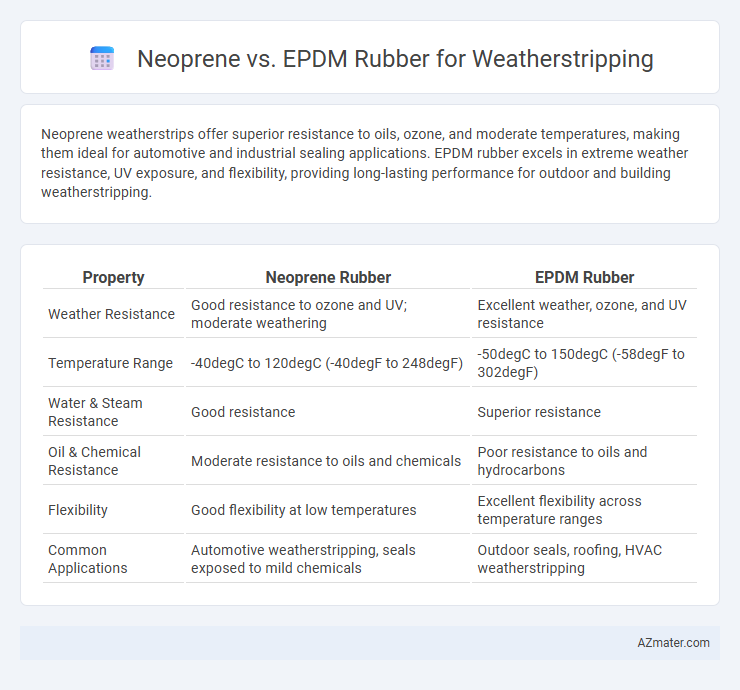Neoprene weatherstrips offer superior resistance to oils, ozone, and moderate temperatures, making them ideal for automotive and industrial sealing applications. EPDM rubber excels in extreme weather resistance, UV exposure, and flexibility, providing long-lasting performance for outdoor and building weatherstripping.
Table of Comparison
| Property | Neoprene Rubber | EPDM Rubber |
|---|---|---|
| Weather Resistance | Good resistance to ozone and UV; moderate weathering | Excellent weather, ozone, and UV resistance |
| Temperature Range | -40degC to 120degC (-40degF to 248degF) | -50degC to 150degC (-58degF to 302degF) |
| Water & Steam Resistance | Good resistance | Superior resistance |
| Oil & Chemical Resistance | Moderate resistance to oils and chemicals | Poor resistance to oils and hydrocarbons |
| Flexibility | Good flexibility at low temperatures | Excellent flexibility across temperature ranges |
| Common Applications | Automotive weatherstripping, seals exposed to mild chemicals | Outdoor seals, roofing, HVAC weatherstripping |
Introduction to Weatherstripping Materials
Neoprene and EPDM rubber are two primary materials used in weatherstripping due to their excellent resistance to weather elements and durability. Neoprene offers superior oil and ozone resistance, making it ideal for automotive weatherstrips exposed to harsh conditions. EPDM rubber provides outstanding flexibility and UV resistance, commonly used in window and door seals to prevent air and water infiltration.
What is Neoprene Rubber?
Neoprene rubber, a synthetic rubber known for its excellent weather resistance, is widely used in weatherstripping applications due to its durability against ozone, UV rays, and temperature extremes. It offers superior flexibility and maintains seal integrity in both cold and hot environments, making it ideal for automotive and industrial weatherstripping. Compared to EPDM rubber, neoprene provides better oil and chemical resistance while maintaining comparable weatherproofing performance.
What is EPDM Rubber?
EPDM rubber, or Ethylene Propylene Diene Monomer, is a synthetic elastomer known for its excellent resistance to weathering, ozone, UV radiation, and extreme temperatures, making it ideal for weatherstripping applications. Its superior flexibility and durability ensure long-lasting seals in automotive, construction, and industrial environments. EPDM's ability to maintain elasticity over time distinguishes it from neoprene, enhancing performance in outdoor and harsh climate conditions.
Weather Resistance: Neoprene vs. EPDM
Neoprene offers excellent resistance to ozone, UV rays, and moderate weather conditions, making it suitable for environments with varied exposure. EPDM rubber boasts superior weather resistance, particularly against extreme weather, UV radiation, ozone, and oxidation, ensuring long-term durability in harsh climates. Both materials perform well for weatherstripping applications, but EPDM is generally preferred for prolonged outdoor use due to its enhanced resilience to weather elements.
Temperature Tolerance Comparison
Neoprene weatherstripping exhibits excellent temperature tolerance, ranging from -40degF to 225degF (-40degC to 107degC), making it suitable for environments with moderate heat exposure. EPDM rubber surpasses this with a wider temperature tolerance of approximately -65degF to 300degF (-54degC to 149degC), offering superior performance in extreme cold and heat conditions. This temperature resilience makes EPDM the preferred choice for outdoor weatherstripping applications needing long-term durability against harsh weather variations.
Chemical and UV Resistance
Neoprene and EPDM rubber both offer strong weatherstrip performance, but EPDM excels in UV and ozone resistance due to its ethylene-propylene composition, making it ideal for prolonged outdoor exposure. Neoprene provides superior resistance to oils, chemicals, and solvents, which benefits applications with potential chemical contact. For chemical and UV resistance, EPDM is preferred where sustained sunlight exposure is critical, while neoprene is chosen for environments with harsh chemical interactions.
Durability and Longevity
Neoprene offers exceptional resistance to oils, UV rays, and ozone, making it highly durable for weatherstripping applications exposed to harsh outdoor environments. EPDM rubber excels in resisting extreme temperatures, weathering, and aging, ensuring long-lasting performance in fluctuating climates. Both materials provide excellent longevity, but EPDM typically outlasts Neoprene in harsh weather conditions due to its superior flexibility and resistance to environmental degradation.
Cost and Affordability Analysis
Neoprene rubber typically costs more than EPDM rubber due to its enhanced resistance to oils and weathering, making it suitable for demanding weatherstrip applications. EPDM rubber offers a more affordable option with excellent resistance to UV rays, ozone, and extreme temperatures, delivering reliable weatherproofing at a lower price point. For budget-sensitive projects, EPDM provides cost-effective durability, while Neoprene remains a premium choice where chemical and environmental resistance justify the higher expense.
Best Applications for Neoprene and EPDM
Neoprene weatherstrips excel in applications requiring high oil, ozone, and weather resistance, making them ideal for automotive door seals, industrial gaskets, and marine environments. EPDM rubber stands out in scenarios demanding superior UV, heat, and water resistance, commonly used in window seals, roofing membranes, and HVAC systems. Choosing Neoprene or EPDM depends on specific environmental exposure and mechanical requirements to ensure durability and performance.
Choosing the Right Rubber for Weatherstripping
Neoprene offers excellent resistance to oil, weather, and ozone, making it ideal for automotive and industrial weatherstripping applications exposed to harsh conditions. EPDM rubber excels in UV, ozone, and extreme temperature resistance, perfect for exterior weatherstripping around windows and doors in residential and commercial buildings. Selection depends on environmental exposure and chemical resistance requirements, ensuring effective sealing and durability in specific weatherstripping applications.

Infographic: Neoprene vs EPDM rubber for Weatherstrip
 azmater.com
azmater.com